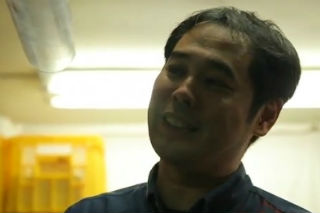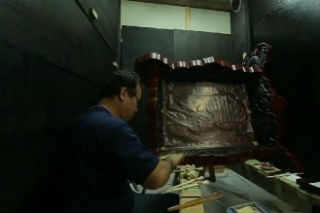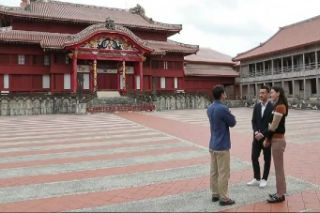Lost during WW2, restoration in progress
Shurijo Castle conveys the brilliant culture of the dynasty as the Shuri Royal Government office. It is estimated to have been built in the late 14th century, but much of it was destroyed in the Pacific War. A full-fledged recovery project has been conducted since the late 1980s, and the restoration and repair work is still underway today. ”Because there was a headquarter of the Japanese army in the vicinity, nothing was left. Restoration is done by analyzing old material,” said Jun Koki, curator of Okinawa Churashima Foundation Shuri Castle Park Management Unit. On the day of Nakata’s visit, the repair work of ”Kofukumon Gate” was under way. The gate is also known as ”Nagaujo”, and the building itself has the function of a gate. For the outside wall, they kept the old original materials, and re-painted them with paints using only natural materials.

Bright vermilion that matches the sun
Some things survived the war. ”The spring water fountain in the shape of dragon sculpture was brought from China in 1523, over 500 years ago. It was damaged by the war, but it is pretty much what it used to be originally,” explained Koki. Nakata replied, ”I’ve never heard stories about the war period. It taught me an important lesson.”
Then, we were shown the restoration process of ”hengaku”, the frame which is used in high places such as gates of houses and shrines. It is a project where lacquerware craftsmen from Okinawa gathered and spent over 10 years. The color of lacquer differs a little from Japan’s mainland, and Okinawa people found beauty in the bold color that is just as bright as the sun. Nakata commented, ”I’m sure the influence of climate is significant.”

From Houshinmon gate to Shurijo Castle main palace
We headed from Houshinmon to the main palace. They found an old picture of Houshinmon a few years ago, and discovered that there were two stone lions placed in front of the gate. Now the lions are set up accordingly. Once inside, visitors are welcomed by the view of the ”Una”, which is an open garden space with red lines made of tiles on the ground, and the main palace with overwhelming powerfulness. At ”Una”, many annual events took place, and people lined up according to their status. The red lines served as the guide for them to line up. In front of the main palace Nakata said, ”Perhaps a castle is a place where the culture of the land is condensed.”




